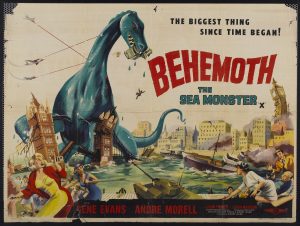
The Giant Behemoth was one of the last giant monster-on-the-loose films of the 1950’s, a decade that saw all manner of creatures born of the two biggest scientific issues of the decade- space exploration and nuclear weapons. Behemoth fell into the second category, a genre started with the excellent Beast From 20,000 Fathoms, and elaborated upon with Godzilla and Them! However, by the time Behemoth rolled before the cameras, the concept of atomically created monsters had already worn thin. Nevertheless, this is one of the better films of its type; a real gem made on a budget so tiny that it wouldn’t even cover the cost of a current feature’s end credit listings!
Credit for the film’s cult reputation must go to the men behind the Behemoth. Although Jack Rabin, Irving Block and Louis DeWitt are first billed in the effects credits, it was King Kong’s Willis O’Brien and his assistant Pete Peterson, that brought the Behemoth to life. Their Paleosaurus- though in some ways reminiscent of the Beast From 20,000 Fathoms-is nonetheless a unique creation, with its long neck and legs giving it a stature that makes it tower over most of its surroundings. The skin of the model is finely detailed, with hundreds of minute scales, while the back has a single row of serrated plates, a very realistic model in spite of the movie’s low-budget pedigree. The animation, mostly created by Peterson while in a wheelchair due to his advanced multiple sclerosis, is superb; Peterson had learned well from master craftsman O’Brien, and ensured the dinosaur’s movements would seem natural, even giving it something of a personality.
Despite Peterson and O’Brien’s expertise, the film does have some technical flaws (the stiff, live-action prop head that rams the ferryboat is regrettable) but effective stop-motion scenes counterbalance these missteps. In an atmospheric night scene reminiscent of Beast From 20,000 Fathoms, the Behemoth, in silhouette, wanders into some power lines, reacting first with shock, then anger as it attacks the high-tension towers. In the first stop-motion scene of the monster rising from the Thames, the Behemoth strides towards the camera, attacks some dockside cranes, and continues forward, eventually passing over the camera- a trademark of O’Brien’s visual style. Sadly, this was also the last film that highlighted his stop-motion work. This makes the movie significant for historians, and a must for buffs.
Another aspect of Behemoth that makes it compare favorably to most of its contemporaries at the time was the direction by Eugene Lourie, and the elegant, understated performances. Lourie (who had previously directed Beast From 20,000 Fathoms) attempted to repeat that success with Behemoth, this time not only directing, but screenwriting as well. However, budgetary restrictions forced Lourie to keep the monster off-screen for a longer time. Instead of shots of the monster actually attacking ships and structures (as Ray Harryhausen had done in Beast) Lourie substituted after-the-fact sequences (such as a beached steamship). Not until the creature has actually entered London is the viewer allowed a good look at it. However, it’s to Lourie’s credit that he eschewed the non-essential romantic subplot typical of most 50’s B-movies. As the film was an Anglo-American production, he made the story into an English mystery of sorts, similar to the Dr. Quartermass films. We know from the start that something radioactive is killing fish and men off the coast of England, but it’s up to the lead characters to solve the riddle of the source of the radioactivity.
In the opening of the film, an American biologist, Steven Karnes (played by Gene Evans) is lecturing a group of scientists about the dangers of not only nuclear weapons testing, but the disposal of radioactive wastes- a warning still timely 45 years later! Evans plays his role straight and understated- he’s the hero, yet doesn’t let his character exceed what would be expected of a scientist investigating an unusual phenomenon. Likewise, his British counterpart, Prof. Bickford (Andre Morrell) also plays low-key. Evans even allows Karnes to undergo a subtle change in his behavior. In the beginning of the movie, Karnes’s blunt, direct (American) attitude puts off the reserved Bickford and other English authorities. Eventually, Karnes begins to adopt a more diplomatic manner, ultimately suggesting rather than demanding that a torpedo be the ideal means of destroying the Behemoth. By treating the film as a detective thriller, Lourie managed to keep it moving, involving the cast in various bits of business that hold the audience even when the animal does not appear. Once the Behemoth surfaces, however, the film exchanges mystery for spectacle, even if on a smaller scale than Beast or Gorgo, Lourie’s 3rd (and most spectacular) monster on the loose epic.
The only real letdown (other than the prop head) is the demise of the creature. Unlike Beast, with its spectacular finale- as the monster reared up before a burning roller coaster and finally expired- (a nice Harryhausen touch) the Behemoth is simply struck and blown up by the torpedo. Instead of a stop-motion shot of the monster dead or mortally wounded, the unrealistic prop head briefly rises for a final time before plunging into the depths of an obvious studio tank. O’Brien and Peterson probably didn’t have time to film the creature’s destruction in a more dramatic fashion, although they were certainly capable of wringing pathos out of their creations. The musical score, by Edwin Ashley, while not as bold as David Buttloph’s for Beast, still provides both low key tension during non-monster sequences and dramatic enhancement during the monster’s rampage. Ashley’s work here was likely influenced by passages from Stravinsky’s Rite of Spring; it has a primitive, visceral power. Those who like their dinosaur thrills high tech (CGI) may find Behemoth dated, but for those who admire old-fashioned craftsmanship, and for fans of this unique genre, I recommend taking a look at this minor classic.

